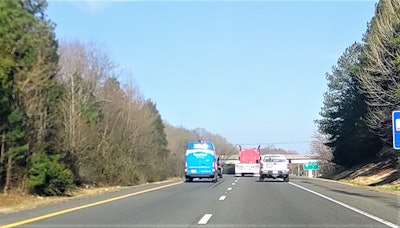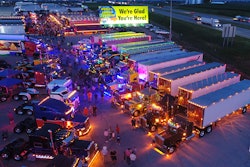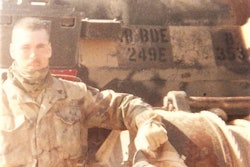
The way that professionals drive for maximum fuel efficiency can be seen as basically the same as driving for safety. The same principles apply to both. Don't think about driving with an advanced assist system as old-school v. new technology. It is old-school enhanced by technology. Merging old-school ways with new-school tools maximizes both safety and efficiency – that’s key for profitability. As fuel prices rise, the best drivers become more valuable.
These are things that professionals can do.
Put the phone away. One of the main components of driving for fuel mileage is awareness. The idea is to keep the momentum. The best drivers see things before they happen. Bad things happen when we don’t pay attention. This could be just getting caught in the wrong lane and braking, and then having to rebuild momentum.
It could be worse. One of the most dangerous things I see is a driver not paying attention.
Increase your following distance. Safety experts ask for at least 4 seconds. Seven seconds leads to greater fuel efficiency. That gives the driver time to adjust speed to a situation and let the vehicle slow itself down. Increasing following distance gives the driver greater visibility. There may be a breakdown, or flashing lights, on the right shoulder. This gives the driver more time to move over, often without hitting the brakes. It also helps the driver react before the vehicle does it automatically.

Think ahead of your safety system. The typical collision-mitigation system, with automatic braking, reacts when you are within 3.6 seconds of the vehicle ahead. Most interactions with the collision mitigation systems are minor braking events. That is basically a tap on the brake to cancel the cruise control. For a driver in that 3.6-second zone, it feels like a harder brake than it really is. It still can be avoided simply by reacting before the system does. It is usually as simple as changing lanes. Adaptive cruise control lets the following vehicle match the speed of a lead vehicle. As noted, this typically happens with an auto-tap on the brake at about 3.6 seconds’ worth of following distance, but will vary depend on your vehicle’s system settings. For those of us who have such systems in place, we have all accidentally used it. The driver may see another truck a mile ahead that is going a bit slower than they are. After a few miles the following vehicle stops gaining on the lead vehicle. The adaptive cruise control has taken over.
Be aware. This can be avoided by changing lanes and passing the slower vehicle.
GPS-assisted cruise control helps the truck manage momentum by using gravity. The driver may notice that the drive train goes into coast mode just before topping a hill. It can be irritating. It does save fuel. The truck knows that it is about to go downhill. (Staying on the throttle at the top of the hill may require the vehicle to engage the braking system sooner going down the hill.) That saves fuel.
Plan your stops. Uphill off-ramps with corresponding downhill on-ramps are better than downhill off-ramps wit uphill on-ramps. Reduce your stops. Right turns are better than left turns. Pull-through parking is better than having to back into a spot. For old-school drivers these are basic fundamentals. Newer drivers might not think about these things. They already are absorbing a ton of information.
Learn to coast into reduced-speed zones, and curves. Let your truck slow without braking. Old-school thinking is that you only use your brakes for stopping. It’s good thinking. The less you use your brakes, the less fuel you use. Safety first. Brake if you need to. Try not to put yourself in the position where you need to.
The driver’s understanding of the truck matters. Too many companies just hand off trucks as if the driver should know everything about every particular truck that exists. Yet trucks continue to constantly evolve. Engines run slower than the engines that I learned on. Respect your drivers. Show them how everything works. Take the time to explain why things work the way that they do. The better that the driver understands the truck, the more efficiently they will use it. The happier they will be with it.
Leave early. The phrase I was in a hurry is often heard at accident scenes. It also makes us less fuel-efficient. The early bird at the outset has the luxury of driving more slowly. Doing so saves fuel. Yes, I understand that we cannot always do this. And profitability is more important than fuel mileage. Don’t miss a $500 load to save $50 on fuel, but don’t waste $50 on fuel when you don’t have to. Hurrying leads to little mistakes, too, like hitting the top of the hill too fast and having to brake at the bottom. Little mistakes add up to poor fuel mileage.
Reduce idling. Even in the old days it was bad for the engine. The tradeoff was wear and tear on the starter. Today’s starters are simply better. Back in the day they lasted 100,000 to 150,000 miles. Today’s starters last about five times that long. Add to that the aftertreatment systems. The higher the idle percentage the more often the engine needs a forced regen. I have driven DEF trucks for 10 years now and only have done one standing regen on the road. That was after a night of idling to protect a beer load at negative 13 Fahrenheit. Having to wait for a standing regen can put the driver in hurry mode. For most over-the-road drivers, such regens are easily avoidable just by reducing idle time.
Be quick, don’t hurry. This is a paraphrase of a quote from the great basketball coach John Wooden. Drivers run up against the 14-hour clock more often than we run up against the 11-hour clock. Wasting 10 minutes wandering around a truck stop may put you into hurry mode later in the day. Do your shopping when that clock isn’t running. When it is, be quick. Finally, safety always comes first. Remember that. Safety and efficiency have a symbiotic relationship, but in the rare instance that they don’t, choose safety.
Find more information about the ins and outs of safety and business processes, among a myriad other topics, in the Overdrive/ATBS-coproduced "Partners in Business" manual for new and established owner-operators, a comprehensive guide to running a small trucking business. Click here to download the newly updated 2022 edition of the Partners in Business manual free of charge.
[Related: Using collision-mitigation systems for a fuel-mileage advantage]










